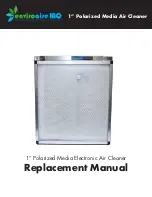
33
Installation
Due to our policy of continuous product innovation, some specifications may change without notification.
©LG Electronics U.S.A., Inc., Englewood Cliffs, NJ. All rights reserved. “LG” is a registered trademark of LG Corp.
Wall Height
Limitations
(When the
Unit[s] is [are]
Surrounded
by Four [4]
Walls)
60 inches
20 in.
>10 inches
>45°
>2 inches
• Wall height at the front of the outdoor unit must be
≤
60 inches.
• Wall height at the inlet side of the outdoor unit must be
≤20 inches.
• There are no height limitations for the walls at the sides of the outdoor unit.
• If the wall heights at the front and inlet sides of the outdoor unit are higher than
allowable limits, additional space must be included.
- Additional space on the inlet side by 1/2 of h1.
- Additional space on the front side by 1/2 of h2.
- h1 = A (the actual height) - 60.
- h2 = B (the actual height) - 20.
Front
Front
Outdoor Unit Installation Space, continued.
PLACEMENT CONSIDERATIONS
Installing Outdoor Units Indoors
Installing Outdoor Units Indoors
LG Multi V outdoor units are engineered to be mounted outdoors and include technology designed to minimize the negative effects of winter
weather’s freezing rain, sleet, and snow. Some building projects, however, necessitate placing the HVAC outdoor units indoors:
• Lack of ground space.
• Lack of an appropriate outdoor location that meets system design requirements.
• When mounting on the roof is not an option due to a lack of roof space.
• Roof warranty will be voided if mechanical equipment is placed on the membrane.
• On retrofit projects, a former chiller/boiler/air handler equipment room, mechanical area, or penthouse already exists.
• Where a project has vertical, self-contained VAV air handlers on each floor (in lieu of a centralized mechanical room).
• To curtail the potential need for redundant zone heating devices such as wall-fin radiators or duct heaters.
• In extremely cold environments where there is a significant amount of run-time at temperatures well below freezing outside the outdoor unit
ambient air temperature range published in this engineering manual.
Benefits of Installing Outdoor Units Indoors
• Shelters the outdoor unit from direct exposure to prevailing winds that decrease the heating capability of the outdoor unit.
• Protects equipment from freezing precipitation and/or potential ice build-up that could hinder unit operation.
• Maintains coil heat transfer efficiency by reducing the number of and shortening the cycle time for defrost operation.
• Easier maintenance and servicing during inclement weather.
• When mounted in a fully enclosed space, limiting the ambient air temperature may allow the Multi V system designer to eliminate oversizing
the outdoor unit to compensate for loss of capacity at low ambient temperatures.
• May also curtail the need to provide inefficient redundant zone heating devices such as wall-fin radiators and second-stage ancillary
heating devices.
Design Considerations Include:
• Enclosure types and elements such as louvers, rain hoods, dampers and controls, heating methods and sizing of heating devices
• Heating strategies
• Duct design
• Condensate handling
















































